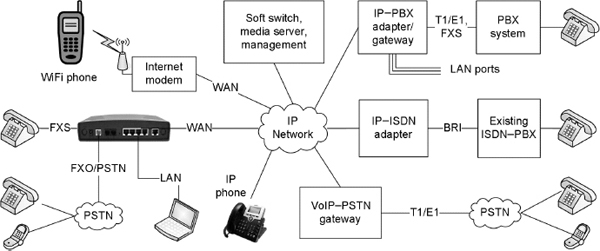2.2 TYPICAL VoIP DEPLOYMENT EXAMPLE
A typical deployment scenario for VoIP is shown in Fig. 2.3. In VoIP deployment, various voice-interfacing CPEs, soft switches, and VoIP–PSTN gateways are associated to establish the VoIP call. The main functions of various supporting infrastructure boxes are indicated in this section. For voice and data applications, CPEs communicate to the IP network through LAN or wide area network (WAN) interfaces. The LAN and WAN interfaces include Ethernet, a digital subscriber line (DSL), a very high-speed DSL (VDSL), a WLAN, a passive optical network (PON), dial-up, cable interfaces, USB, and more.
The software running on computers and add-on cards with voice interfaces can also function like the CPE and communicate with the Internet through LAN interfaces. VoIP adapters have simple voice and LAN data functions, whereas IAD or RG will have a direct WAN interface with many data-centric LAN interfaces. The IP phone is a single-user CPE terminal used to make a VoIP call. CPE terminals are also called end points.

Figure 2.3. Typical VoIP deployment functions.
VoIP–PSTN gateways establish the routing of calls to the existing PSTN network. These gateways are connected to the PSTN network through T1/E1/J1, ISDN, and FXO interfaces. Based on the signaling protocol used, the SIP server, the MGCP media gateway controller, or the H.323 gatekeeper establishes the ...
Get VoIP Voice and Fax Signal Processing now with the O’Reilly learning platform.
O’Reilly members experience books, live events, courses curated by job role, and more from O’Reilly and nearly 200 top publishers.

